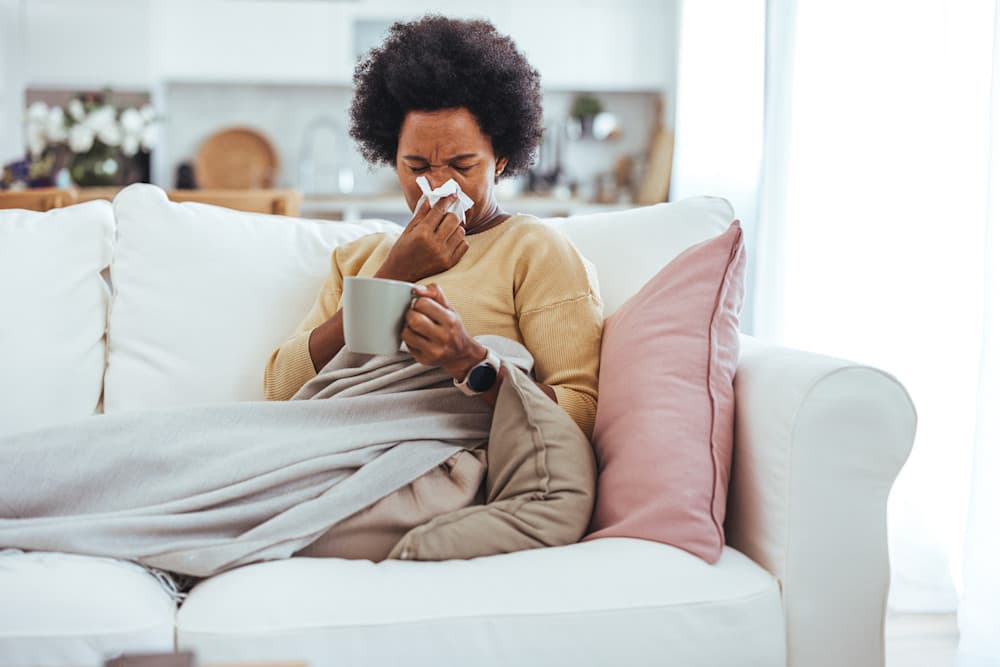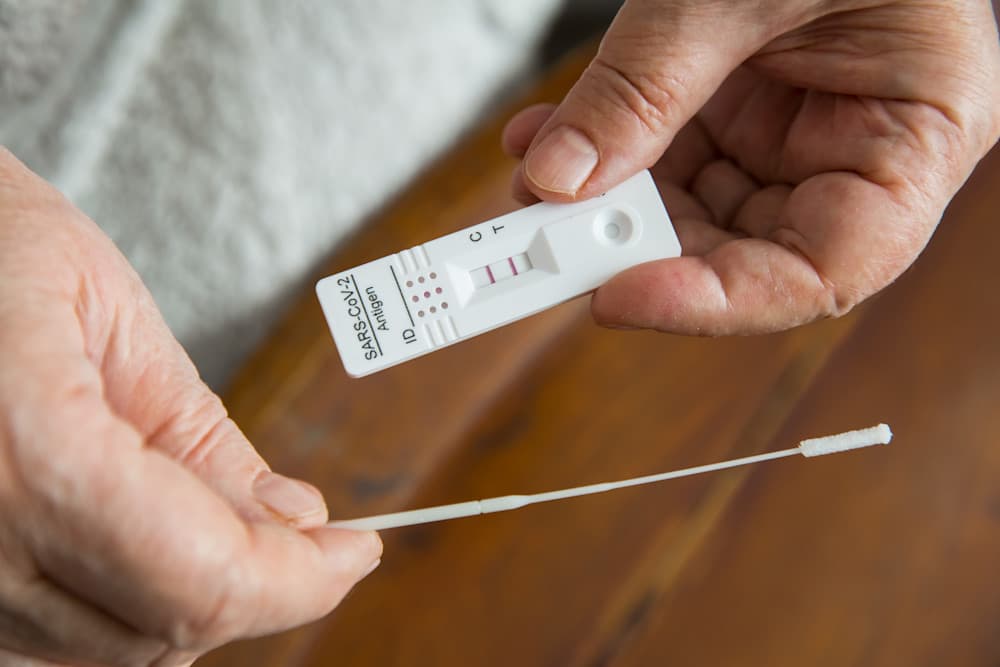How preventive healthcare measures can help you manage the quademic

7 Minutes

Team Curative

Feb 5, 2025
You’re probably painfully aware that winter illnesses have been especially severe this season. There’s a reason for this: the Quademic, a group of viruses that strike simultaneously. If the Quademic affects you, focus on preventive care and take steps to minimize your symptoms. Read on to learn how you can prevent and treat the Quademic.
What is the Quademic?
Starting in late 2024, Americans began seeking treatment in significant numbers for four illnesses: COVID-19, RSV, norovirus, and flu.
While the term “Quademic” may sound scary, public health experts say the quadruple threat isn’t so different from other common respiratory illnesses. Your best bet for staying healthy this winter is to follow best practices for avoiding illness, including hand-washing, isolating when experiencing symptoms, and getting updated vaccines.

What are the illnesses included in the Quademic?
RSV
Respiratory syncytial virus (RSV) causes lung and respiratory tract infections. RSV is a common illness, and in adults and older, healthy children, its symptoms are usually mild. In these cases, self-care measures are usually enough to resolve symptoms. Most people recover within two weeks, though the severest cases may require a hospital stay. Symptoms include:
congested or runny nose
dry cough
low-grade fever
sore throat
sneezing
headache
Flu
Influenza, or flu, is an infection of the nose, throat, and lungs. While a cold may start slowly, the flu tends to come on quickly. Common symptoms include:
fever
cough
headache
muscle aches
extreme fatigue
sweating and chills
Most people recover from the flu independently and do not need to see a healthcare provider. But if emergency symptoms emerge, you should seek care as soon as possible.
Norovirus
Norovirus infection occurs suddenly and causes severe vomiting and diarrhea. It is highly contagious and typically spread through contaminated food, water, surfaces, and close contact with an infected person. Norovirus symptoms usually last one to three days. Most people recover completely without medical treatment. However, some children, older adults, and people with underlying medical conditions may require medical care for dehydration.
COVID-19
Many people with COVID-19 have no symptoms or mild illness. But for older adults and people with certain medical conditions, COVID-19 can be life-threatening and require acute medical care. Symptoms often vary but include:
dry cough
shortness of breath
loss of taste or smell
fatigue
digestive problems, including upset stomach, vomiting, or diarrhea
headaches and muscle aches
fever or chills
cold-like symptoms, including congestion, runny nose, and sore throat
You may experience a few symptoms or none. If you test positive but have no symptoms, you are asymptomatic. Both people who are sick and those who are asymptomatic can spread COVID-19 to others.

How can I protect myself?
To protect yourself during the Quademic season, follow healthcare providers’ advice about best practices for virus prevention. This means doubling down on hand-washing. Because norovirus, in particular, is highly contagious, you should “make ample use of soap and water,” because alcohol-based hand sanitizer alone may be insufficient, says infectious disease expert Dr. William Schaffner. Medical experts suspect that people have stopped practicing good hand hygiene with the threat of the COVID-19 pandemic behind us. Washing your hands thoroughly with soap throughout the day can prevent transmission of norovirus and other Quademic viruses.
On-schedule vaccinations are also critical to staying healthy during Quademic season. Being immunized against common viruses is fundamental to preventive care. Unfortunately, many Americans are currently under-vaccinated for the flu. According to the CDC, 42.7% of adults and 41.9% of children had been immunized as of the end of 2024. Though no vaccine is currently available for norovirus, vaccines are available for COVID-19 and flu. An RSV vaccine is available and recommended for older Americans and those in high-risk groups.
Other preventive care practices that can help you prevent or cope with the Quademic include:
Regular testing using rapid COVID-19 tests help identify cases early and prevent transmission.
Wear a high-quality mask in crowded settings during virus outbreaks.
Improve indoor ventilation by opening windows or using air purifiers.
Stay home when you are sick to prevent spreading illness.
When should I see a provider?
Monitor your symptoms if you are sick with any of the Quademic viruses. If you experience severe or unusual symptoms, see your healthcare provider. RSV can be especially severe. For babies, older adults, and immunocompromised people, RSV can cause severe infections that can cause pneumonia or inflammation of the airways. You should seek medical attention if you experience fever, severe cough, wheezing, rapid breathing, difficulty breathing, or a bluish tinge to the skin.
During surges of infection like the Quademic, doctor’s offices, emergency rooms, and urgent care clinics may fill up with patients seeking care. Telehealth services ease the burden on healthcare facilities. These services ensure you get qualified medical care without having to go to a healthcare clinic. You can be seen by a provider from home during a telehealth appointment to minimizee the risk of infection for others and ensure you can continue to practice self-care and rest.

What tests and treatments are available?
COVID-19 tests are widely available and are important in minimizing the spread of infections.
Many healthcare providers also perform RSV tests to discover if RSV is the cause of cold symptoms in infants, older adults, and people with weakened immune systems. Rapid and molecular RSV tests exist; both are administered via nasal swab. People with mild symptoms may be tested as part of public health efforts to track the spread of the virus.
Early flu testing plays an important role in treatment. In some cases, your healthcare provider may prescribe flu antivirals to make your symptoms milder and shorten the duration of your illness by about one day. These medications may also prevent serious flu complications, including pneumonia. Rapid antigen tests and molecular tests are available. Most people, however, recover from the flu without antiviral medications.
Though norovirus is an unpleasant experience, the infection usually clears up within a few days and isn’t life-threatening. Vomiting and diarrhea can cause dehydration, so you should drink plenty of fluids and seek medical attention from your primary care doctor if you experience symptoms of severe dehydration. These can include severe fatigue, dry mouth and throat, listlessness, dizziness, and decreased urine output.
Curative health insurance: easing members’ Quademic burden
Curative is a new kind of employer-sponsored health insurance that focuses on affordability, engagement, and simplicity. By prioritizing preventive care, Curative supports members’ optimal health. Curative plans cover the healthcare best practices that help protect you from the Quademic and get you on the path to healing if you experience symptoms.
Curative offers three innovative and affordable health insurance plans: EPO, PPO, and PPO Max. As long as members complete a Baseline within the first 120 days of their plan start date, they continue with $0 copays, $0 deductibles, and $0 out-of-pocket costs for all covered services and providers listed in the Provider Search.
Curative healthcare plans cover:
preventive care, including vaccines
testing
provider visits
Curative also covers telehealth visits, so members have easy, convenient access to medical providers from the comfort of home. Curative offers 24/7/365 telehealth to ensure members get care when they need it. Members can access $0 telehealth care on demand in under 10 minutes via messaging, audio, or video chat.
About Curative
Curative is a health plan employees love for its affordability, engagement, and simplicity. With $0 copays and deductibles, members can get the care they need when they need it without the financial burden. Imagine — a health plan that actually delivers better health without hurting your wallet.
With its innovative approach to preventive healthcare, Curative is a powerful ally during Quademic season and throughout your healthcare journey.
Curative members have access to virtual health services to stay well. For quick and easy care, use Curative Telehealth through the Member Portal. For mental health support, explore our mental health resources to find the right platform for you.
To see all disclaimers, please view here.
Resources
Asin, Stefanie (2025, January 8). Norovirus and the ‘quad-demic’: what to know. Becker’s Clinical Leadership.
Assure (2025). Quad-demic Concerns: Managing COVID, Flu, RSV, and Norovirus.
https://assure-test.com/quad-demic-concerns-managing-covid-flu-rsv-and-norovirus/
Leake, Lindsay (2025, January 13). Public health experts are warning of a ‘quad-demic’ this winter. Here’s where flu, COVID, RSV, and norovirus are spreading. Fortune.
https://fortune.com/well/article/winter-quad-demic-flu-covid-rsv-norovirus/
Mayo Clinic (2025). Coronavirus disease 2019 (COVID-19).
https://www.mayoclinic.org/diseases-conditions/coronavirus/symptoms-causes/syc-20479963
Mayo Clinic (2025). Norovirus infection.
https://www.mayoclinic.org/diseases-conditions/norovirus/symptoms-causes/syc-20355296
Mayo Clinic (2025). Respiratory Syncytial Virus.
Medline Plus (2025, January 7). Flu (Influenza) Tests. https://medlineplus.gov/lab-tests/flu-influenza-test/
Medline Plus (2025, January 7). Respiratory Syncytial Virus (RSV) Tests. https://medlineplus.gov/lab-tests/respiratory-syncytial-virus-rsv-tests/
Sign up for our Newsletter
Índice de Contenidos
What is the Quademic?
What are the illnesses included in the Quademic?
How can I protect myself?
When should I see a provider?
What tests and treatments are available?
Curative health insurance: easing members’ Quademic burden
Resources







